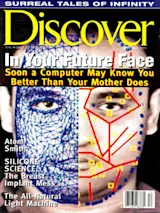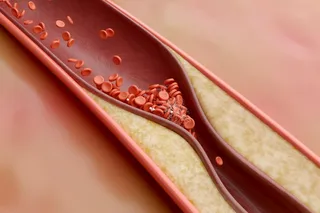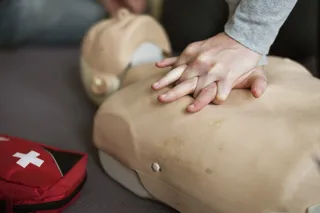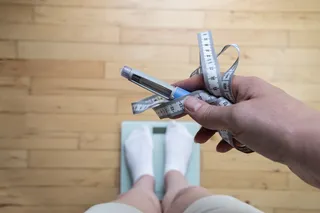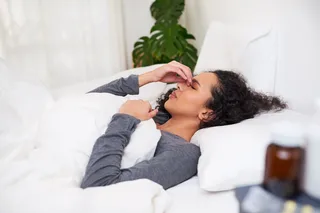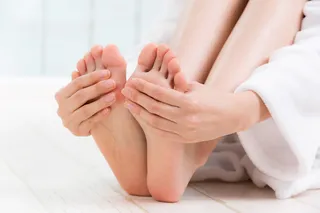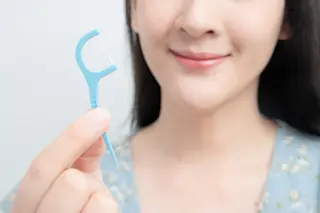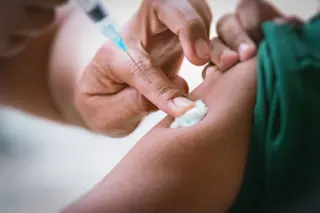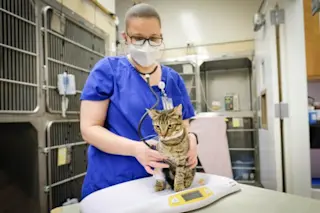When Pamela Johnson’s case came to trial three years ago in Houston, the 46-year-old had recently had her third set of silicone breast implants removed. Set number one had lasted from 1976 to 1989, when she complained to her plastic surgeon that her breasts had hardened, apparently because scar tissue was forming around the implants. The surgeon performed a treatment called a closed capsulotomy, which is to say he squeezed Johnson’s breasts, hoping the manipulation would break up the scar tissue. Instead it ruptured her left implant. Confronted with what would later be described in news reports as a runny mess, he performed a partial mastectomy and replaced the old implants with pair number two. Johnson found the new implants aesthetically unpleasing and consulted another surgeon, who installed pair number three in November 1989. Though she complained of chronic fatigue, night sweats, hair loss, and headaches, Johnson kept them until June 1992. After physicians suggested that her ailments were caused by silicone in her system, Johnson had pair number three removed and sued the Medical Engineering Corporation, a subsidiary of Bristol-Myers Squibb, which had manufactured her first two sets of implants. Her lawyer was John O’Quinn, a legendary Houston plaintiff’s attorney. At the time, O’Quinn had some 800 implant cases in the pipeline.
Because the trial hinged on the scientific legitimacy of the silicone-related diagnosis, O’Quinn enlisted several expert witnesses, including Nir Kossovsky, a pathologist at the UCLA Medical Center, to testify to the havoc that silicone could wreak on the human immune system. The jurors later said that Kossovsky’s testimony had played a critical role in their decision. They awarded Johnson $25 million, $20 million of it for punitive damages. Johnson’s was the second multimillion-dollar settlement against the manufacturers of implants. A third followed in 1994: a $40 million judgment against the 3M company. In all three, Kossovsky’s expert testimony on the deleterious effects of silicone helped make the difference.
In the spring of 1994 a group of U.S. implant manufacturers, led by Dow Corning Corporation, agreed to pay $4.2 billion to women who believed their implants had caused them harm. Even that astronomical settlement, however, soon appeared as if it might not be enough, with $1 billion going to attorneys and the remainder split among 440,000 plaintiffs. And thousands more plaintiffs had opted out of the settlement, hoping to take on the implant manufacturers independently. This past May, Dow Corning attempted to stem the financial hemorrhaging by declaring bankruptcy. In September 1995 the agreement collapsed and negotiations began on a new settlement.
Throughout the controversy, Kossovsky has played a crucial role in the courts. He has served as a consultant to the Food and Drug Administration advisory committee whose 1992 hearings led to a moratorium on implants, and his views on silicone immunology have been cited not only by this magazine but by such publications as Science, the New York Times, and U.S. News & World Report. O’Quinn’s firm refers to him as the senior world authority on the biological properties of silicone. Impressive credentials for a pathologist without board certification in either rheumatology or immunology, the scientific disciplines central to the controversy.
In fact, Kossovsky’s fame as an expert witness is based largely on a theory that remains unsupported by scientific evidence, and on a test Kossovsky claims can detect silicone-induced disease, although recent research has found no evidence that such a disease even exists. Epidemiological evidence from a number of studies, done at Harvard, the Mayo Clinic, and elsewhere, indicates that although silicone from implants may cause local problems in a body, there’s no proof that it causes systemwide harm. Some of the most august bodies in science--including the American Medical Association, the American Society of Plastic and Reconstructive Surgeons, the FDA advisory panel on General and Plastic Surgery Devices, and committees commissioned by the Canadian, British, and French governments--agree with that assessment. While it may be premature to reject completely a link between silicone implants and disease, in the words of the British Medical Devices Agency, the balance of the evidence is clearly tilting towards such a conclusion.
The chasm between Kossovsky’s courtroom claims and the scientific evidence suggests that mainstream science and the legal system have parted ways, which would not be unusual. Good science requires time to reach reliable judgments, while the courts, in the interest of practical justice, are eager to establish guilt or innocence quickly. The cases against implant manufacturers have been won not on the strength of scientific evidence but on the suffering of the plaintiffs, the apparent indifference of the manufacturers to proving definitively that their products are safe, and the willingness of the plaintiffs’ experts to state their opinions with what in the world of science outside the courts would be very unscientific certitude. Kossovsky is not the only researcher to become involved in the legal aspects of the silicone controversy, but he is among the most visible and influential; moreover, he has become an example of the expert witness with questionable expertise.
According to Kossovsky, his experience with silicone began in 1981 when, as a second-year medical student at the University of Chicago, he read all two dozen volumes of a Dow Corning report on silicone. The material was considered ideal for devices implanted in the body because it appeared to be chemically inert--it would not interact chemically with other materials--so researchers concluded it couldn’t do much harm even if buried for decades in a living organism. As Kossovsky tells it, the executive summary of the Dow Corning report made that contention, but the rest of the two dozen volumes included some evidence that silicone induced inflammation and even lymphomas in patients and animals. It kind of didn’t add up to much, he says. It wasn’t conclusive. All it did was leave a big question mark.
It also prompted Kossovsky to run a few experiments with his adviser, a microbiologist and immunologist named John Heggers, on silicone in guinea pigs. Kossovsky says the studies, which they published in 1983, showed that in the guinea pigs silicone could induce a sensitivity to their own blood proteins. This sensitivity, he speculated, might be the first step in a process that could lead to an autoimmune disorder--that is, a disease such as rheumatoid arthritis in which the immune system goes haywire and attacks the body’s own tissues.
Between 1984 and 1987, Kossovsky trained in pathology at Cornell University Medical Center and then moved to UCLA, where he expanded his speculations on silicone into a theory of its effect on the immune system. His theory depends on the silicone molecule’s notorious stickiness. Once silicone leaks from an implant, he explains, it becomes coated with proteins from the body, just as a cherry dipped in chocolate becomes instantly coated with the chocolate. This, he says, changes the structure of the proteins, which are normally long, intricately coiled and knotted chains of chemical building blocks called amino acids. Silicone untangles, or denatures, these proteins, he says, altering their shape: it’s a fundamental biophysical phenomenon of surface chemistry.
Kossovsky then ventured into immunology. When the body finds unfamiliar substances such as viruses or bacteria inside it, the immune system generates defense molecules, called antibodies, and launches them on a search-and-destroy mission. The invaders, called antigens, carry molecular flags that allow the antibodies to identify them. The immune system usually generates specific antibodies for each specific antigen. Kossovsky hypothesized that once silicone denatured tissue or blood proteins, the immune system would no longer recognize those proteins as belonging in the body and would generate antibodies to attack them. These antibodies might then erroneously attack the original proteins as well, and the result would be an autoimmune disorder.
Researchers later said that Kossovsky’s theory was not to be dismissed out of hand and was certainly worthy of being tested. But whether Kossovsky ever adequately did that is a matter of debate.
In the late 1980s an increasing number of anecdotal reports linking silicone implants to autoimmune disorders--in particular rheumatoid arthritis, lupus, and scleroderma--caught the media’s attention. Everyone agreed that when the implants ruptured, for example, or when scar tissue that had formed around them hardened and contracted, the local effects of breast implants could be quite horrible, in the words of Marcia Angell, executive editor of the New England Journal of Medicine. More controversial were the systemic effects. How did the body as a whole react to silicone? Did silicone’s presence cause disease--in particular, autoimmune disease? The reports that it did arose from physicians confronted with women who had come down with the diseases only after getting their implants, although a causal relationship between the two had not been established. While the anecdotal reports were compelling, as Angell explained in a New England Journal editorial, plenty of women contracted autoimmune disorders without ever having implants. Thus, she wrote, the postulated associations were very difficult to evaluate.
When the FDA called for a moratorium on the use of silicone implants in 1992, it was not because they had been shown to be unsafe but because the evidence didn’t exist to prove whether they were or not. Nor had the manufacturers accumulated sufficient evidence to say how long breast implants might last, or how frequently they would leak or rupture. Nonetheless, those who hadn’t paid close attention--which meant the bulk of the American public and much of the press--took the FDA decision to mean that implants were indeed dangerous.
While epidemiologists began looking for data to determine whether women with implants suffered more frequently from autoimmune diseases than those without, laboratory researchers hunted for evidence that silicone and the human immune system were an unhealthy combination. This was a confusing proposition. Silicone, a simple molecule composed primarily of silicon and oxygen, pervades our culture and possibly our bodies as well. Most antacids, for instance, use silicones as fillers, as do some breakfast cereals. Norplant birth control devices are coated with it. Even underarm deodorants incorporate silicone, which is probably absorbed through the skin. We’re bathed in this stuff, says Buddy Ratner, a University of Washington bioengineer.
Kossovsky was brought onto the scene in 1990, when he received a call from a women’s advocacy group requesting that he look at specimen slides of breast tissue from women with implants and health problems. To Kossovsky, the slides showed a range of patterns from gross amounts of silicone and inflammation to relatively minimal biological reactions, which indicated various local responses to the implants.
The slides were just the beginning, though. In a newsletter, the advocacy group printed Kossovsky’s name near the name of John Heggers, his former adviser, who was collecting blood samples from women with implants. Blood starts coming to me, says Kossovsky. From women all over the country who think they’re sending blood for some study. So I call up John. I say, ‘I got blood.’ I send it down. This goes on for quite some time, and it’s beginning to get downright expensive to forward the blood.
Eventually, Heggers said he had enough blood and told Kossovsky to hold on to the rest--hundreds of samples from women with breast implants who claimed to be suffering from various unspecified illnesses. Kossovsky saw it as a golden opportunity to test his hypothesis about the immune response to silicone. If the silicone denatured the blood and tissue proteins in these women, he reasoned, they should have antibodies against the silicone-denatured proteins, and those antibodies should be detectable. All he had to do was design the right kind of assay, just like an HIV test or any other test, he says.
The assay he came up with was an ELISA test, a test researchers say can seem simple to use but can be extraordinarily difficult to interpret correctly. The starter equipment consists of a dish, known as an ELISA well, made of polystyrene plastic. Like silicone, polystyrene holds tightly to proteins that come in contact with it. Step one in an ELISA is to coat this well with the specific antigen to which you’d like to find antibodies. The antigen sticks to the polystyrene. Then you add serum--the fluid component of blood that’s left after the cells have been removed. If the serum has antibodies specific to your antigen, they’ll latch onto the antigen, which is stuck to the polystyrene. Then you wash away the excess serum, and, with luck, what’s left will be the antibodies you were looking for, stuck to the antigen, which is stuck, of course, to the polystyrene.
This is a simplistic description and seems straightforward. But circumstances in an ELISA well can get very tricky. For instance, if you don’t coat your polystyrene completely with your antigen, then all the antibodies in the blood--whether they’re to your antigen or to some other substance--will stick to the polystyrene, because almost anything sticks to polystyrene. So when you find antibodies at the end of your test, it doesn’t mean you found the specific antibody you were looking for. It means you botched the procedure. Furthermore, the test gives not a simple yes or no but a highly subjective range of values. In the words of Noel Rose, an immunologist at Johns Hopkins, these values can be influenced by many things: by the technician who did the test, by the temperature, humidity, and many imponderables. The absolute value you get changes from day to day; so you don’t like to compare tests from different days, only the serum samples run by a single technician on a single plate on a single day. ELISA tests must be done with extreme care, and even researchers with years of experience have to question whether they have interpreted their results correctly.
Kossovsky, though, proceeded as if ELISAs were relatively simple. He himself trained undergraduate volunteers to run the tests. The students coated the ELISA wells with silicone, then added proteins common in human blood and tissue, such as collagens and fibrinogen, expecting that the silicone would denature them. Then they tested 249 of the blood samples Kossovsky had kept, pouring the serum into the wells to see whether it had antibodies that would bind to the presumably denatured proteins.
At this point, even if the ELISA revealed the presence of these antibodies, Kossovsky would still have no idea whether they were unique to women with implants. Perhaps all women had such antibodies. Or maybe all women with autoimmune diseases, even those without implants. Or maybe all women who have had major surgery, which an implant operation certainly is. Indeed, women could get denatured proteins for lots of reasons--infections could do it, for instance, as could local inflammation around the implants, or scar tissue from an operation. Diseases like rheumatoid arthritis might cause misfolded proteins to float around in the blood, even in people who didn’t have implants. So Kossovsky would have to test the blood from women sick and healthy, with implants and without, to see whether women with implants and symptoms not only had antibodies to these denatured proteins but were the only ones who did (or at least had more of them than the other groups). Only then could he come to some scientific conclusion.
For the first of his necessary comparisons, then, in October 1991 Kossovsky collected blood samples from 47 healthy women without implants. A few months later he was put in contact with researchers from the Autoimmune Disease Center at Scripps Research Institute in La Jolla, California, who were intrigued by his test and his theory. They agreed to send him blood from women with diagnosed autoimmune diseases, which he could test with his assay. In March 1992 he received blood samples from 40 nonimplanted women with autoimmune diseases, 10 healthy women without implants, and 11 with implants and autoimmune diseases. Scripps sent the blood blinded, which meant Kossovsky wouldn’t know which blood sample came from which woman. He would have to run the samples through his test and send the results to Scripps, and Scripps would break the code. Then the researchers would know if Kossovsky’s test revealed that women with implants and symptoms of autoimmune diseases had antibodies to denatured proteins, or at least more of those antibodies than other women.
In April, Kossovsky sent his test results, and the Scripps researchers broke the code. Kossovsky’s test failed to distinguish women with autoimmune diseases and implants from women with autoimmune diseases and no implants. Though it might be able to tell which women had autoimmune diseases, it couldn’t say whether the diseases were caused by silicone breast implants. And for that limited purpose it was unnecessary--there were already many tests available that could do that. The Scripps researchers wrote Kossovsky of the results, says Scripps rheumatologist Robert Fox, and assumed that would be the end of it, at least as far as Scripps was concerned.
But two years later, in 1994, the institute began receiving calls from patients, physicians, and even a university clinic, asking about Kossovsky’s test, apparently assuming that Scripps had either validated the test or was offering it. Fox, thinking this mistaken conception had come from Kossovsky, wrote him twice more, repeating that his test could not distinguish women with silicone-related disease and requesting that he refrain from any mention of Scripps Clinic patient data. Fox says his two letters to Kossovsky constituted a gentlemanly way of explaining that the test didn’t test what Kossovsky wanted it to. With his failure to respond to the data I sent him, says Fox, I thought that he had gotten the message.
Fox also initiated a statistical reanalysis of Kossovsky’s test results from April 1992. He described the results of the reanalysis in a 1994 letter to Stephen Miller, a plastic surgeon at Scripps and the University of California at San Diego who was then president of the American Association of Plastic Surgeons. Not only did the analysis fail to provide evidence that Kossovsky’s assay detects autoimmunity related to silicone implants, wrote Fox, but the ELISA values Kossovsky had obtained for his own healthy nonimplanted women had differed significantly from his values for the healthy nonimplanted women from Scripps. That meant that Kossovsky’s research had fundamental problems. If the tests had been run properly, the results from all the healthy women should have been consistent, regardless of where they were from. In other words, wrote Fox, the entire ELISA must be considered invalid and rerun.
But Kossovsky was of a different opinion. He seems to have believed in his test even before he had begun the collaboration with Scripps--which means before he had the chance to run his test on any patients with diagnosed autoimmune disorders and compare those results with results from the implanted patients. As far back as 1991, in a California trial, he testified about the immune response to silicone, helping the plaintiff win a $7 million judgment against Dow Corning. His opinions on the matter, he said, were based in part on the preliminary findings of his study.
As far as the Scripps critique was concerned, Kossovsky says, the purpose of having Scripps collaborate was not so researchers there could tell him whether his test worked but so he could sort all the women he’d tested, including the Scripps patients, into groups--implanted women, healthy controls, and nonimplanted women with autoimmune disease. Then, when they broke the code, he could do his own analysis. As for the correspondence from Fox, says Kossovsky, he sent me a huge packet of stuff, a very bizarre rambling letter, that didn’t make any sense to me.
When he drafted a paper on his work toward the end of 1992, he rejected the Scripps analysis and provided his own. He compared 39 of the 40 autoimmune patients from Scripps with his 249 sick, implanted women and his 47 healthy, nonimplanted women. Then he reported that 9 of the 249 women with implants had scored so high on his ELISA tests--higher than any of the others--that they must have an unnatural amount of antibodies to denatured proteins, implying that they must be suffering from a silicone- related disease. What this disease was, Kossovsky couldn’t say. Aside from a greater incidence of fever and foot pain, he later said, the 9 women had symptoms little different from those of the other 240 implanted women, whose ELISAs had not been particularly high.
Kossovsky’s paper was rejected by at least three scientific journals before being published in 1993, in the peer-reviewed Journal of Applied Biomaterials, where Kossovsky was a member of the editorial board. Researchers who read it commented that it had numerous errors, including several flaws with the ELISA assay, and one obvious and glaring problem-- the number of subjects from which Kossovsky deduced his dramatic conclusions.
The problem was simple. Kossovsky had reported that the ELISA scores of 9 of his 249 women with implants were significantly higher than the mean score of the 47 healthy women or of the 39 women with autoimmune disorders. But those 9 women represented less than 4 percent of all the women with implants he tested. What if in reality his ELISA test was meaningless? Then he might expect 4 percent of all women to score equally high. Because his two comparison groups had comparatively few women, 4 percent of those would be fewer than two from each group. With numbers that small, it was not particularly surprising that he got zero instead of one or two. When the groups are of uneven sizes, interpreting the results requires extreme caution.
Imagine, for instance, that Kossovsky had decided to test the theory that something completely unrelated to the immune system--height, say--would determine whether a woman had a silicone-induced disease. The taller the woman, the more likely her breast implants caused autoimmune problems. If so, it would be easy to imagine that 9 of 249 women with implants might be taller than any of the 47 nonimplanted women or the 39 autoimmune patients, simply because there were so many more women in the implant group than in the other two groups. Only if Kossovsky had compared large enough, roughly equal numbers of women--say, 249 from each of the three groups--could he have concluded that it might be meaningful in some medical sense that the 9 highest scores were all from the women with implants. Of course, if a large number of the implanted women, say 50 or more, scored higher than any of the others, that would be compelling even with uneven comparisons.
Many scientists who read Kossovsky’s paper thought that Kossovsky had an interesting hypothesis, but nothing in his paper made them believe it was right, let alone that his test worked. He is basing his conclusions on the hypothesis itself, says John Butler, a University of Iowa immunologist. When you have a hypothesis, you have to do very thorough experiments to test it. But it seems as if he interprets having the hypothesis as being equivalent to having the data. The details that are so critical for the assay are lacking to such an extent that by the time he comes to making the final conclusion, as a scientist I’ve already lost interest. The British Medical Devices Agency reviewed Kossovsky’s research and concluded that it was not possible to draw any definitive conclusions from this work. . . . Kossovsky finds these criticisms extreme. The paper should not be taken so seriously, he later explained; all it said was that there was something very screwy that suggested there was something going on here.
Nevertheless, with a paper published and a patent application filed through the University of California, Kossovsky founded SBI Laboratories in Pittsburgh to market a blood test, which he called Detecsil, as in detect silicone. His partners in the company were his wife, Beth Brandegee, and his father, Ram Kossowsky (father and son spell their surname differently).
By March 1994, SBI was advertising Detecsil as a definitive answer as to whether subjects are experiencing an immune response to silicone. One advertisement in Trial, a magazine for plaintiffs’ lawyers, read: Representing clients in silicone-related litigation? Consider this: The Detecsil test confirms whether or not an individual has developed an immune response to silicone-associated proteins. Detecsil provides valuable answers to those studying silicone immune reactions in at-risk populations. . . .
Those at-risk populations, according to SBI, included not just the estimated one million women with silicone breast implants but anyone with any silicone prosthesis or occupational exposure to silicone, or even diabetics who injected insulin through hypodermics lined with silicone. People who scored high on the Detecsil test would be informed that they had an immune response to silicone--and, by implication, a good lawsuit. Those who wanted the test were instructed to send blood and $350 to SBI. The potential profit for such a test seems clear. If Detecsil could be valuable to one million implanted women, not to mention the other at-risk populations, then SBI Laboratories stood to take in hundreds of millions of dollars in business. (Kossovsky, however, says that as of September 1995, neither he nor his wife had profited in any way from the operations of the lab.)
Advertising the test, though, presented Kossovsky and his family with a serious problem, which did not go unnoticed by the FDA. Because SBI was offering the blood test as a service rather than a kit that could be purchased, the FDA had little regulatory control. The agency could insist, however, that the test be advertised truthfully.
In July 1994 the FDA informed SBI that although its promotional material included the caveat for research use only, this was contradicted by claims that imply Detecsil is a diagnostic tool. For instance, the claim that Detecsil is the first and only test to detect an immune response to body proteins damaged by silicone seemed to imply some sort of diagnosis. In a letter to SBI, the FDA warned that until Detecsil had proven diagnostic ability, the promotion was misleading and SBI was violating federal regulations.
This conceptual dilemma led to some equally confusing attempts to clear up the issue. For instance, in court depositions Kossovsky had to describe exactly what his test could do for women who were paying $350 to see the results, when he couldn’t claim that it could diagnose any illness. Kossovsky admitted that the test would not determine if someone was sick. So what could it do? It was, Kossovsky later explained, a research tool and a legal tool.
A legal tool?
One of the biggest problems right now in this growing silicone mess, he explained, is how to identify patients that really have some evidence of silicone-induced reactions and distinguish them from patients who might have had scleroderma, for whatever reasons, and have implants, and patients who say they have all sorts of symptoms and have nothing going on with them. But, once again, that seemed to imply a diagnostic test. It was all very confusing. At any rate, this past May SBI Laboratories applied for FDA approval of Detecsil as a medical device and suspended sales of the test shortly thereafter.
Perhaps the most perplexing aspect of Kossovsky’s research to be revealed by his courtroom testimony was the state of his raw data. Researchers like to keep log books and laboratory records for years, sometimes indefinitely, so they can support their published claims. But when the lawyers for the implant manufacturers subpoenaed Kossovsky for his data, hoping to make some sense of his test, he gave them little more than drafts of his paper and of the charts that appeared in it--no lab books or raw data. In a June 1994 deposition, Kossovsky explained that most of his data, perhaps all, had been lost during a Los Angeles earthquake.
The data, Kossovsky said, had been piled in stacks on his office floor. During the earthquake, some partially consumed mugs of coffee or water or combinations thereof, some of which may have been growing microbiologic species, and some other fluid containers that were lying around also in close proximity to the edge of the desk and the large pile on the floor and a lot of things got very wet and quite disgusting. As a result, he procured two large garbage cans and discarded everything that looked disgusting or not particularly important.
Do you know, asked one of the lawyers, whether you looked at a piece of paper and said, ‘This is data from a recently published study that I ought to hold on to even if it is wet’?
That statement never went through my mind, Kossovsky replied.
In March 1995, Kossovsky announced that he had some new data, having concluded a study based on blood samples run at SBI in Pittsburgh. He reported the results at a meeting hosted by the National Cancer Institute and the National Institutes of Health, claiming that Detecsil could distinguish with extraordinary accuracy patients with breast implants and symptoms from a variety of control groups. The numbers, however, seemed as disparate as before: this time Kossovsky compared 310 women with implants and unspecified ailments with 173 healthy women without implants, 88 women without implants and diagnosed with autoimmune diseases, and only 11 women with implants but no symptoms. Kossovsky says the Detecsil test was based solely on this new data, not on that included in the 1993 paper, although he was unable to explain why the company had been advertising Detecsil several months before they started compiling the new data. (One brochure even asserted that the Detecsil silicone sensitivity test is based on data gathered in more than a decade of research on silicone breast implants, contradicting his claim.)
Shortly after the meeting, SBI began sending out newsletters that quoted Kossovsky as saying his new research constituted the strongest human data to date that link silicones to immune diseases. According to SBI, at least 200,000 breast-implanted women were expected to show a link between silicone and disease. With their barrage of marketing, Kossovsky and SBI seemed to be making an effort to counter the accumulation of epidemiological studies showing no evidence of silicone-induced immune disorders, the latest of which was published in June in the New England Journal of Medicine. This one was the largest yet: a 14-year study of 87,501 nurses, of whom 876 had silicone implants. The researchers, led by Harvard epidemiologist Graham Colditz, found no association between silicone breast implants and autoimmune disease. Kossovsky claimed that maybe silicone caused some kind of unidentified illness, characterized not by the usual symptoms of autoimmune disorders but by a collection of symptoms such as dry mouth, hair loss, fatigue, and sleep disturbances. But the Harvard study showed no evidence to support that contention either.
Kossovsky, of course, insists his studies are right and the epidemiological studies are limited. Those studies, he explains, don’t look for the right symptoms or diseases. I kind of feel like Galileo, he says. The Earth still moves.
In the end, why should we be concerned if Kossovsky is another Galileo or just a man selling a test and expertise that appear to be of dubious significance at best? After all, there will always be researchers who make claims that can’t be substantiated, and even researchers who make money off such claims. But many other scientists worry about how such claims affect science and the public. In our society, scientists have authority by nature of their profession. The public trusts their word and puts them on a pedestal. But, says Robert Fox, like plastic surgeons who persuade women that breast implants will improve their lives, researchers who make unsubstantiated claims don’t deserve the public trust. Women with breast implants who have fatigue, joint problems, and other poorly defined symptoms need to understand that physicians share their frustration with our failure to understand their symptoms, Fox says. However, it does not provide a useful service for them to use a poorly controlled lab test that can create fearfulness about imbalance in their immune system.
Such concerns are echoed by Stephen Miller, also of Scripps, though he takes pains to point out that he is anxious about the promotion of all unconfirmed theories, not only Kossovsky’s. The issue is a very uncomfortable one, says Miller, and very uncomfortable for patients. Most of us have spent enormous amounts of time with people who are panicked about something we don’t know that they should be. These people are petrified, and I don’t know that it’s not because a chicken is screaming that the sky is falling down.


